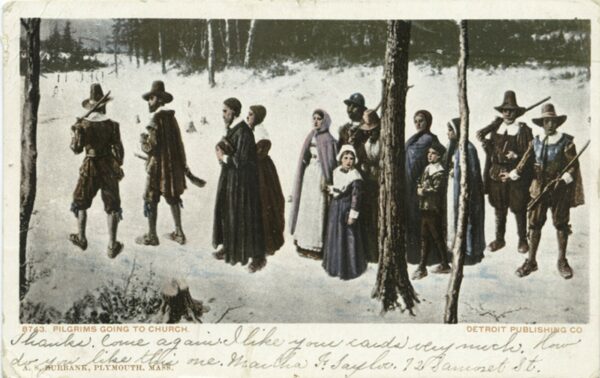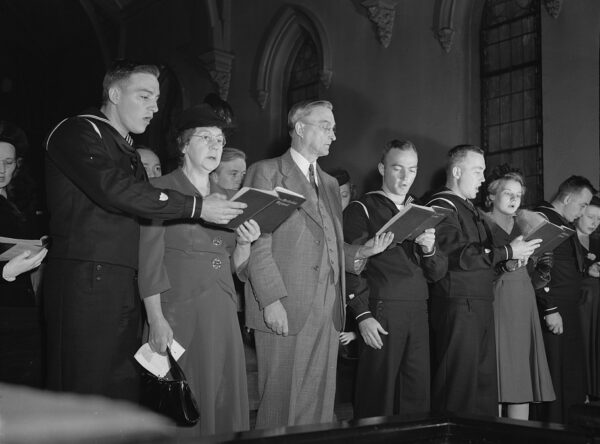A History of Thanksgiving Day: From 1621 to the American Revolution
The Pilgrims of Plymouth observed only three kinds of holidays. Each Sunday they observed the “Sabbath” by worshipping and hearing sermons.

Postcard illustrating Pilgrims going to church.
Courtesy of The Miriam and Ira D. Wallach Division
of Art, Prints and Photographs: Photography Collection,
The New York Public Library.

This illustration from The American Continent
and its Inhabitants Before its Discovery by Columbus
by Annie C. Cady shows Pilgrims going to church.
Courtesy of the Library of Congress.
The Pilgrims also held days of Fasting and Humiliation and days of Thanksgiving. They called for a day of Fasting and Humiliation when they felt God’s hand of judgment and for a day of Thanksgiving when they saw special blessings. Days of Fasting or Thanksgiving were usually held on Thursday, the regular day for their mid-week church meeting. There is no record that the harvest celebration of 1621 was an official Thanksgiving for the Pilgrims. Of course, they would have thanked God for the food.
The Pilgrims actually held their first official day of Thanksgiving during the summer of 1623 after God sent a rain that saved their crops. Governor Bradford wrote about their native nation neighbors’ astonishment over this blessing from God. It was not until the 1800s that Americans began to refer to the Pilgrims’ 1621 harvest celebration as the “first Thanksgiving.”
Over the years, settlements throughout New England began having annual Thanksgiving holidays during the autumn. Authorities in a community would simply announce a date and residents would start preparing for the celebration. By the middle of the 1600s the custom of having an annual Thanksgiving was firmly established.
In 1777, during the American Revolutionary War, the Continental Congress declared a day of Thanksgiving after the American victory over the British at the Battle of Saratoga. The Continental Congress continued to declare a day of Thanksgiving every year through the end of the war in 1783. In 1779, a young woman, Juliana Smith, wrote a letter to a friend telling her about her family’s Thanksgiving celebration. From this letter we learn how they celebrated and what foods they enjoyed at their feast.
Before the meal, they went to church. Family members took turns hosting the dinner each year, while guests helped out by bringing food. Servants served the host family and their guests who sat around tables in the dining room.
They had no beef because all of it had to go to the Continental Army. Instead of beef, they had venison, pigeon pasties, pork, turkey, and goose. For dessert they had pumpkin pie, apple tarts, and Indian pudding.
While still at the table, some of the men sang hymns and ballads. Then the group sang a hymn and were led in prayer. After dinner, they crowded around the fire telling and listening to stories.
Eventually the Dutch hymn “We Gather Together” became a traditional hymn for Thanksgiving. Adrianus Valerus wrote the hymn in Dutch in 1597 and called it “Wilt Heden Nu Treden” in Dutch. The hymn was published in a Dutch hymnal not long after the Pilgrims arrived in Plymouth. Thirty-one Dutch families arrived in America in 1623 and began to form New Amsterdam, now New York, in 1624.
“Wilt Heden Nu Treden” was later translated into German. In 1894 Theodore Baker translated it from German to English. This is Baker’s English translation:
We gather together to ask the Lord’s blessing.
He chastens and hastens His will to make known.
The wicked oppressing now cease from distressing.
Sing praises to His name; He forgets not His own.
Beside us to guide us our God with us joining,
Ordaining, maintaining His kingdom divine.
So from the beginning the fight we were winning.
Thou, Lord, wast at our side; all glory be Thine!
We all do extol thee, Thou leader triumphant
And pray that Thou still our Defender wilt be.
Let Thy congregation escape tribulation.
Thy name be ever praised! Oh, Lord, make us free.
I like knowing that some of our Thanksgiving traditions have been around for so long.

Four of Mr. and Mrs. Wayman Fincham’s six sons
who were serving in World War II attend church services
with their parents on Thanksgiving Day in 1942.
Courtesy of the Library of Congress.
Children find comfort in keeping traditions. We adults do, too.

Pumpkin pies at the Crouch family Thanksgiving Day dinner
in Ledyard, Connecticut, November 1940. Photo by Jack Delano.
Courtesy of the Library of Congress.
Of even more comfort is knowing that God is on our side and that “from the beginning the fight we were winning.” Our children need to know that. We adults do, too.
By this we know that we love the children of God, when we love God and observe His commandments. For this is the love of God, that we keep His commandments; and His commandments are not burdensome. For whatever is born of God overcomes the world; and this is the victory that has overcome the world—our faith. Who is the one who overcomes the world, but he who believes that Jesus is the Son of God?
1 John 5:2-5

